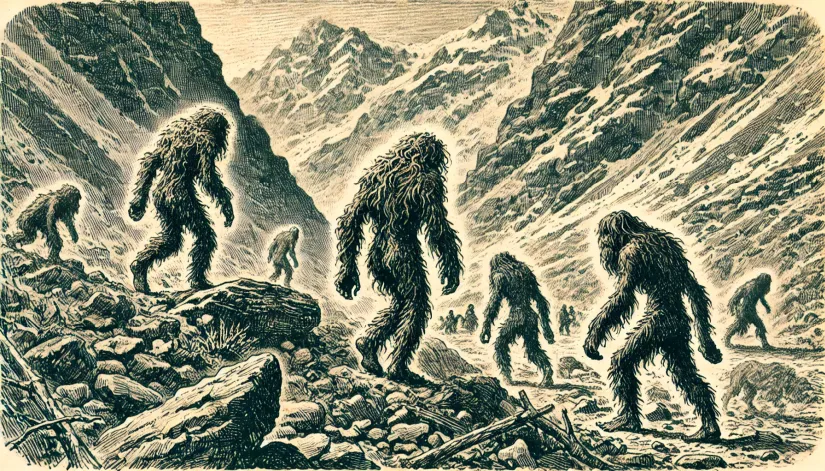Rumors of the Almas—a mysterious “wild man” from Mongolia and Central Asia—have fascinated explorers and cryptozoologists for centuries.
Some think it’s a relic species of ancient humans. For others, it’s pure folklore. But that didn’t stop dozens of expeditions from looking for the definitive proof that Almas was real.
So, is it true that the Almas may be a living relic of humanity’s ancient past or pure folklore? Here’s everything we know about this cryptid:
In this article:
What is the Almas?
The Almas is one of the best-known Asian cryptids in folklore. However, in the United States, his fame is largely overshadowed by other similar cryptids like Bigfoot or the Yeti.
Things are completely different in Mongolia and Central Asia. Here, stories of this “wild man” have been told for centuries.
Origin and Meaning
The name “Almas” has a profound meaning in Mongolian and Central Asian culture. While commonly understood to mean “wild man,” the term’s roots extend much more profoundly.
In Mongolian, it translates directly to “wild person.” However, it can also be associated with demons and evil spirits—often taking on a supernatural connotation.
Similar terms are used across the region. Two good examples are the “kiik adam” (Kazakh folklore) and the “Kaptar” (Tajikistan). In both these regions, the Almas is feared as a potentially dangerous and aggresive creature.
That’s probably why some etymologists suggest the term “Almas” may be derived from “ala” (meaning “to kill”) and “mas” (which can translate as “animal”). However, this theory is linguistically speculative.

Physical Description and Characteristics
Coincidence or not, the Almas’s physical characteristics are pretty consistent across different regions. We’re talking about a bipedal animal between 5 and 6.5 feet tall. Its body is fully covered in thick reddish-brown or dark hair. It also has some distinct humanlike features: a flat nose, a protruding forehead, and a weak chin.
Interestingly, many accounts also mention foul odors and loud, distinct screams. Females are often described as more ferocious. Especially when protecting their young.
Despite its humanlike appearance, the Almas is tremendously strong and can run incredibly fast. It’s also well adapted to survive in the harsh environments of the Altai Mountains, Gobi Desert, and other remote regions.
Historical Sightings and Legends
Throughout history, explorers, soldiers, and even scientists have reported encounters with the Almas. These documented sightings span centuries, taking us from the Middle Ages to the modern era.
Let’s take a closer look at some of the most notable sightings and encounters:

Hans Schildtberger’s 1420s Encounter
The first documented alleged encounter with the Almas likely is the one of Hans Schildtberger (a Bavarian soldier who was taken prisoner by Tamerlane in the early 1420s).
Schildtberger writes about a peculiar incident in his diaries: two “wild people” were offered to the Khan as a gift. The soldier described the two humanoids in great detail: both were covered in thick fur (except for their faces and hands) and behaved more like animals than humans.
What makes this sighting particularly compelling is its context.
SpookySight recommends:
- Barmanou: The Beast of Chitral. Real or Myth?
- The Complete Hierarchy of Hell: Who Are the 72 Rulers of Hell?
- Inside the Warrens’ Occult Museum: Haunted Objects and Paranormal Controversy
First, Schildtberger wasn’t just some traveler or local villager. He was an experienced soldier and chronicler who most likely recorded his experiences accurately.
Secondly, this early report places the Almas in Mongolia, near the Altai Mountains.
And finally, these creatures were rare, valuable (or just unusual) enough to be a sought-after gift to royalty.
Nikolai Przhevalsky’s 1871 Wildmen Sighting
Another significant sighting comes from Nikolai Przhevalsky—a Russian explorer best known for discovering Przewalski’s horse.
While traveling through Mongolia in 1871, Przhevalsky reported seeing what he described as wildmen in the same region: the Altai Mountains.
Like Schildtberger, he also remarked that the creatures he spotted were covered with hair, strong, highly agile, and easily navigated the rugged terrain.
Przhevalsky’s reputation as a scientist and naturalist gives this sighting a particular weight. He was a trained observer of nature, which makes his report of wildmen more credible than typical second-hand folklore.
K.A. Satunin’s 1899 Caucasus Sighting
In 1899, K.A. Satunin (a Russian zoologist) claimed to have seen an Almas in the Caucasus Mountains. Satunin’s sighting is significant because it’s the first report of a possible Almas outside Mongolia.
In his notes, Satunin wrote that the strange creature was moving with an oddly human-like gait.
The 1925 Pamir Mountains Incident
Perhaps one of the most dramatic encounters with the Almas happened in 1925 in the Pamir Mountains. What happened? Several Russian soldiers—tasked with capturing rebels hiding in a cave—were shocked to see how an Almas attacked the insurgents.
General Mikhail Topilski documented the event. He noted in great detail how the Almas fought the rebels one by one until it was eventually shot and killed.
Ivan Ivlov’s 1963 Altai Mountains Sighting
In 1963, Ivan Ivlov, a Russian pediatrician traveling through the Altai Mountains, claimed to have seen a family of Almases. It’s the first report of a group of Almases.
Yet, Ivlov’s account is even more intriguing because he later interviewed local children about the creatures he saw. The children confirmed they had seen the Almases multiple times, speaking about the beast as if it were a regular part of their environment.
Why is this relevant? Because it may suggest that Almas sightings were not rare in the Altai region. And that local populations had a long-standing familiarity with the creature.

The Kiik Adam Capture (Early 20th Century)
Another alleged encounter with a wildman took place in the early 20th century. Two Kazakh hunters captured what they believed to be a female “kiik adam” in the Altai Mountains.
According to the story (keep in mind there is no written record of this, just local stories being told for generations), they tied the creature to the pole of their yurt (a traditional nomadic tent), where it spent the night clawing at people and crying out.
By morning, the hunters were so overcome with pity for the poor animal that they decided to release it back into the wild.
Dordji Meiren’s 1937 Encounter
In 1937, a guy named Dordji Meiren (a local Mongolian) reported seeing an Almas skin used in a Buddhist monastery in Mongolia. The monks used the skin during their protection rituals.
Related: Mapinguari Sightings: Is a Real-Life Monster Hiding in the Amazon?
According to Meiren, the skin was hairy and unlike any other known animal species, leading many to believe it may have been the hide of an Almas.
Zhambyn Dashdondog’s Research (2003)
Mongolian researcher Zhambyn Dashdondog dedicated much of his life to collecting sightings and stories of the Almas. His study focused heavily on sightings from Western Mongolia during the 1960s, where locals frequently reported seeing wildmen in the mountains.
After decades of research, he published his findings in 2003 in the book “The Last Almas.”

Zana: The Captured Almas
The most controversial report, by far, is the story of Zana, a supposed female Almas who was captured in the 1850s in Abkhazia. Unlike most sightings, Zana was reportedly kept in captivity for years. During that time, she bore at least four children with local men.
Zana had dark skin and her body was covered in hair. She refused to wear clothes or eat cooked food. She was also very powerful, being able to carry loads and move quickly through the wilderness.
SpookySight recommends:
- What is the Marozi, Kenya’s Legendary Spotted Lion?
- Top 11 Most Bizarre and Terrifying Native American Cryptids
- Is the Flatwoods Monster Real? An In-Depth Investigation of the 1952 Sighting
But, perhaps the most bizarre aspect of Zana’s tale is the 1960s study of her descendants conducted by Igor Bourtsev (cryptozoologist). He examined the skulls of her children, finding them to have slightly unusual features compared to the average human.
Bourtsev concluded that Zana could have been a relict hominid, potentially a Neanderthal or Homo erectus.
However, in the 1990s and early 2000s, a team from Oxford University, led by the geneticist Bryan Sykes, conducted a series of DNA tests on bone and hair samples belonging to Zana’s son (Khwit) to determine their genetic origin.
The results revealed that Zana’s descendants were of modern human origin. Specifically of sub-Saharan African ancestry. This finding suggests that Zana herself was likely an enslaved African woman brought to the Caucasus region. So, the idea of her being a relict hominid was ultimately debunked.
Almas vs. Other Cryptids: Yeti, Bigfoot, and Others
The Almas shares some obvious similarities with other well-known cryptids, such as Bigfoot and the Yeti. However, it also has key differences that make it unique.
Comparative Anatomy and Behavior
The most striking difference between the Almas and a Bigfoot or Yeti is size. Unlike the tall Bigfoot (often described as being between 7 and 10 feet tall), the Almas is much smaller (5 to 6.5 feet), which is more in line with the average human height.
On the other hand, the Yeti (original to the snowy regions of the Himalayas) is usually portrayed as even larger and bulkier than Bigfoot.
Another critical distinction lies in how these cryptids behave. For example, most Bigfoot and Yeti encounters suggest they typically avoid humans.
In contrast, the Almas has been reportedly spotted closer to human settlements, sometimes even interacting with nomadic tribes in Mongolia and Kazakhstan.
Another less-known (but very similar) cryptid is the Orang Pendek (Sumatra). This creature is also reported to be smaller and more humanlike. Some researchers speculate that it could be a surviving population of a previously unknown primate or even an early hominid.
Scientific Theories and Possible Explanations
Like most cryptids, the Almas has inspired much scientific debate. Some theories suggest it might be a relic from humanity’s past, while others point to more practical explanations.
Let’s break down the most popular theories about the Almas mystery, from ancient hominids to misunderstood animals:
Could the Almas Be a Relict Hominid?
One theory suggests that the Almas could be a relict hominid. Possibly a surviving population of Neanderthals or Homo erectus.
This idea is supported by the fact that regions like the Altai Mountains and the Pamir Mountains have been largely isolated for centuries. So, they could be a potential refuge for ancient species.
Cryptozoologists like Igor Bourtsev believe that the Almas’ humanlike features—such as its flat nose and protruding forehead—suggest it might be more closely related to early humans than apes.

The Gigantopithecus Theory
Another theory suggests that the Almas could be a surviving relic of Gigantopithecus—an extinct genus of giant apes that lived during the same period as early humans.
This creature could grow up to 10 feet tall, though the Almas is described as much shorter.
SpookySight recommends:
- Who Was Vseslav of Polotsk, the Werewolf Prince and Sorcerer King?
- Our Complete Guide to Werewolves: Origins, Cases, and Traits
- Is the Loch Ness Monster Real? What We Really Know
The Gigantopithecus theory supporters think that the Almas’ more ape-like features (such as its body hair and strength) could make it a closer relative of Gigantopithecus rather than humans.
If true, it could place the Almas closer to other Asian cryptids (like the Yeti), which some also believe to be a surviving Gigantopithecus.
Neanderthal Adaptation
The Neanderthal Adaptation theory suggests that if Neanderthals survived into more recent times (particularly in isolated regions like the Altai Mountains or Central Asia), they could have evolved over thousands of years.
In that case, Neanderthals would have adapted physically and behaviorally to their changing environments. Possibly developing traits that distinguish them from their ancient ancestors.
For instance, they may have developed greater intelligence, enhanced survival strategies, and more sophisticated behaviors. This could also explain why most Almas sightings describe it as humanlike in terms of both appearance and actions.
A compelling argument is the Denisovan fossils and Neanderthal remains discovered in the Altai region. Researchers believe that Neanderthals and Denisovans coexisted here for thousands of years. Possibly even interbreeding.
Genetic studies from the Max Planck Institute (which confirmed that Neanderthals in the region had a unique genetic profile compared to those in Europe) give this theory even more weight.
Misidentifications
It’s no secret that the “misidentification” theory is commonly used as an attempt to debunk pretty much every cryptid. The Almas makes no exception.
Some claim that the Almas is likely the result of misidentifications of known animals (such as bears). It’s not uncommon for people to mistake a bear, especially one standing on its hind legs, for a bipedal creature.
Given the Almas’ reported strength and hairiness, a bear seems like a plausible explanation for some sightings.
Other sightings could also be linked to people with genetic conditions, such as hypertrichosis, which causes excessive hair growth all over the body.
This condition could account for reports of hair-covered humanoids living in isolated areas, particularly if those individuals were ostracized or living in remote conditions.
Expeditions and Collected Evidence
The hunt for the Almas has spanned over a century, with multiple expeditions seeking to prove its existence. From early scientific pursuits to more modern investigations, researchers have searched for physical evidence like footprints, hair samples, and even body parts.
1906: Badzar Baradiin’s Pursuit in the Gobi Desert
One of the earliest recorded expeditions related to the Almas occurred in 1906 when Badzar Baradiin (a Buryat Mongol scientist) reportedly chased after an Almas in the Gobi Desert.
The problem with this report? There’s absolutely no evidence to support Baradiin’s story. It’s probably why critics later speculated that the account might have been fictionalized to capture public interest.
1950s: Soviet Almas Research under Boris Porshnev
Interest in the Almas took off during the 1950s when the Soviet Academy of Sciences created a formal commission to investigate cryptids (including the Almas).
The group was led by renowned Russian anthropologist Boris Porshnev, whose research focused heavily on snowmen and wildmen sightings across Central Asia.
One of the researchers, Rinchen, was tasked with compiling reports from locals, documenting stories, and mapping sightings. His work was the first formalized attempt by the Soviet government to study cryptids, as cryptozoology became a growing field of interest.
However, despite several expeditions and interviews, no definitive physical evidence was found—at least not according to the Soviets.

Footprints and Hair Samples
A number of expeditions in the Altai Mountains reportedly collected footprints and hair samples attributed to the Almas. The samples were later used as evidence in cryptozoological circles.
However, the DNA testing disproved most of this evidence, and none of the samples could definitively demonstrate that the Almas is real.
Sergey Semenov’s Discovery of an Almas Limb
In 2003, a Russian researcher named Sergey Semenov made an extraordinary claim: he had discovered what appeared to be the leg and foot of an unknown species in the Altai Mountains.
The limb was tested and found to be several thousand years old. However, it couldn’t be definitively linked to the Almas (or any other known species).
The Dead Almas in Bulgan
One of the most striking yet unverified claims happened in 1980 in Bulgan, a rural area of Mongolia. A worker at an agricultural station reported finding the body of a dead Almas.
Despite this potentially groundbreaking discovery, scientists never examined the body. And the story never progressed beyond local rumor.
Our Take
At SpookySight, we love exploring the mysterious cryptids, and the Almas is one of the most intriguing yet.
Over centuries, people from wildly different cultures have described creatures with strikingly similar traits: humanlike, hairy, strong, and agile. The fact that so many stories match up? Well, that feels like it might be more than just coincidence.
However, despite all the research, expeditions, and enthusiastic searches for evidence—whether it’s footprints, hair samples, or even bones—there’s still no conclusive proof that the Almas exists.
Sure, some tests gave us interesting results. And there have been more than a few unexplained sightings. But without solid, undeniable proof, we can’t say for sure if this Asian cryptid is real or not.
So, what do you think? Is the Almas just a tale spun through the ages, or could there really be something (or someone) out there, hiding in the mountains, waiting to be discovered?







